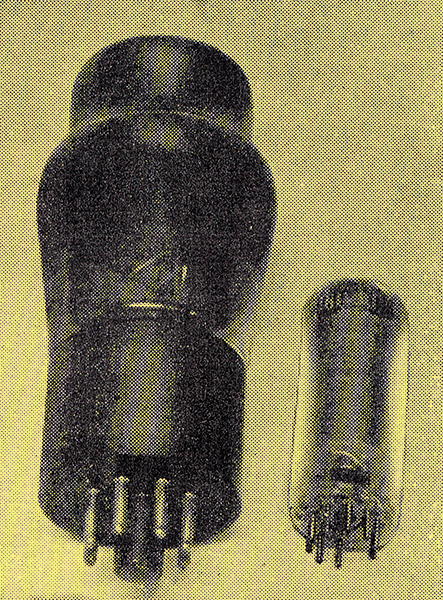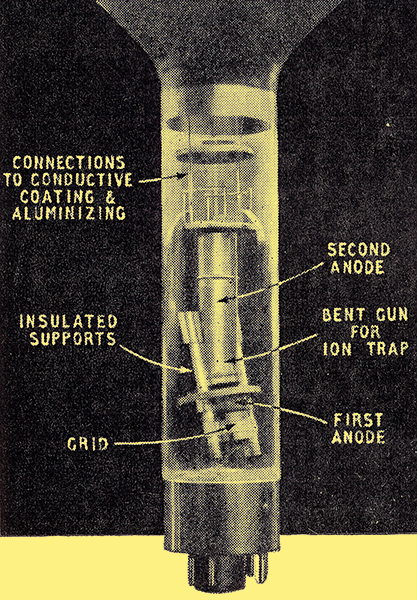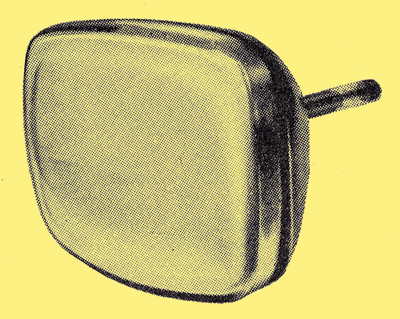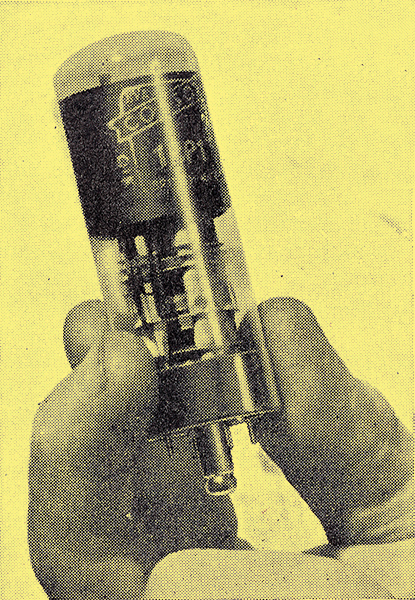|
It is not exactly surprising to find that practically all the new receiving valves being produced nowadays are either designed specifically for television or with a very wide-open eye to their possible use in such circuits. Indeed, with manufacturers describing them glibly as 'video pentodes', 'line-scan output valves', 'booster diodes', 'EHT rectifiers' and so forth, one almost tends to forget that they are, when alls said and done, just ordinary valves. But apart from the question of terminology there is no doubt that these valves all reflect in their electrical and physical characteristics the trend of design of the modern television receiver.
At the moment the prevailing trends are towards AC/DC circuits, to give receivers that are small, light and cheap, and wide-angle cathode ray tubes to satisfy the continual demand for bigger pictures. Consequently the newer valves are all miniature types, with 0.3-amp heaters designed for series running, with characteristics that make the most of the necessarily low HT supply, and with outputs capable of driving the wide-angle CR tubes. Most of them are on the B9A base rather than the B7G. This is partly because the extra pins are needed for multi-electrode and double valves and partly because the slightly larger envelope allows of greater power ratings-it is the glass alone which sets a limit to the dissipation.
One new valve at the Show which typified this trend was the Osram N339 power pentode, intended mainly for use as a line time-base output valve in AC/DC television receivers. It is on the B9A base and has a 0.3-amp 20-Volt heater, and in spite of its small size (2.75in high and ).875 in diameter) it will deliver a peak anode current of about 300 mA at an anode voltage of only 85. The mutual conductance is 9 mA/V and the maximum power dissipation just under 15 watts. This valve, like many of its contemporaries, has been designed with the 'knee' of its anode characteristic at a very low voltage, so that a large anode current swing can be obtained with a low anode voltage-and also with a small power dissipation.
In the realm of the RF amplifying valve, however, the impact of modern television technique has not produced any startling developments, for there were plenty of types in existence already that satisfied all the requirements of wide-band amplification. Even the necessity of operating these valves at low anode voltages in AC/DC sets does not have any really detrimental effect on their characteristics. The general trend, then, is quite a normal one towards higher mutual conductance, higher input impedance, lower inter-electrode capacitances and lower noise levels. A typical example at the Show was the new Brimar 6BW7 pentode, suitable for RF, IF and video amplification. Again it is a miniature all-glass valve on the B9A base and has a 6.3-V, 0.3-A heater. With an anode voltage of 180 Volts the mutual conductance is 9mA/V while the input impedance at 50 MHz is 14kΩ. The input capacitance is 10 pF and the output capacitance 3.5 pF.

Size comparison between Brimar 6V6 beam tetrode and its modern miniature equivalent the 6BW6 shown on the right.
Considering the miniature valve generally, there is evidence of some very great improvements in all-round performance and reliability in the last year or so. No longer is it the precocious problem-child of the industry, and no longer do cautious engineers regard it with suspicion. Indeed, a study of some of the latest types reveals that they are now considerably better than the old normal-sized valves from which they were originally derived. Undoubtedly, the reason for this has been the large demands of the television set-making industry, which have forced manufacturers to pay special attention to the design and mass-production of these valves - and made such attention well worthwhile.

Electrode structure of Mullard cathode ray tube (large-size demonstration model).
Developments in television cathode ray tubes are still largely controlled by the simple human failings of Mrs. X of Acacia Grove, who, when she goes to buy a television set, is determined to have a bigger picture than Mrs. Y next door. The thing of the moment seems to be the rectangular tube with a 17-in diagonal, and most of the well-known manufacturers had their own versions on show at the Exhibition, although not all of them were actually in production. These were all wide-angle tubes with anode voltages in the region of 15 kV.
The next size down is the 16-in tube with an anode voltage of about 12 kV, and at the Show it was represented by one new all-glass type and two steel-cone types. In spite of the metal shortage the steel cathode-ray tube still seems to be keeping its foot in the door, so to speak, and undoubtedly it deserves recognition for the very attractive feature of its light weight. The 16-in type, for example, weighs only 14 lb as against the 20 lb of its all-glass counterpart. But the steel tube is more expensive at the moment, and only when Mrs. X drives the screen diameters up to about 20in and all-glass tubes become difficult to make, will it begin to show an advantage in price. (The solitary 21-in tube at the Show was a steel-cone type.)
Coming down to the more familiar 15-in tube, one of the latest models at the Show was the Ediswan CRM152B. This was interesting by virtue of the fact that the glass face of the screen was tinted grey to give the same effect as an anti-halation filter placed in front of the tube. (The idea may have sprung from a recent suggestion that grey-tinted phosphors might be used.) But, of course, although this scheme undoubtedly improves the picture in the same way as a separate filter, it still suffers from the inherent disadvantage of reducing the light output of the screen./p>

Ediswan 17-in rectangular cathode ray tube, type CRM171.
The smallest of the new wide-angle tubes on which manufacturers are now concentrating seems to be the rectangular type with a 14-in diagonal. It gives an effective picture area nearly 40 per cent greater than that of a 12-in circular tube, and the cubic space it occupies in the cabinet is about 40 per cent less. The latest versions at the Show were the Ferranti TR14, with an octal base and 4-V heater, and the Mullard MW36-22, with a B12A base and 6.3-V heater. Both are operated with about 10 kV on the anode and require a modulating signal of the order of 30 V. The TR14 carries on the tradition of all/previous Ferranti tubes of doing without an ion trap, which, the makers say, is not necessary if the tube is properly de-gassed to prevent the formation of ions in the first place. Nevertheless, the screen has an aluminized backing which would serve as a protection against ion burns if by some mischance the tube were not properly de-gassed.

Cossor 1CP1 miniature cathode ray tube for waveform monitoring.
With all the attention that is being focused on the cathode ray tube as a means of displaying television pictures, one almost tends to forget that it is also a useful device for observing waveforms. However, oscilloscope tubes were quite well represented at the Show. Two of the latest were the 1608CCHE double-gun tube made by GEC. and the 1CP1 miniature tube by Cossor. The last-mentioned is remarkable for its small size (1-in diameter screen) and for the fact that the focusing of the beam is automatic and only one anode potential is required (about 500-800 Volts).
|